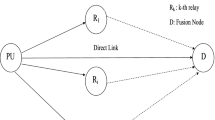Abstract
In this paper, we propose a new cooperative spectrum sensing algorithm using distributed switch and stay combining (DSSC). There are a primary user, one or two relays and a fusion node (FN). Spectrum sensing is performed at FN using the amplify and forwarded signals from the relay. DSSC consists to maintain the chosen relay if the corresponding end-to-end signal to noise ratio is larger than a threshold T. Otherwise, we switch and use the second relay. We derive and optimize the detection probability of DSSC by setting the value of threshold T. We show that the proposed DSSC offers better performance than previous algorithms using all participating (AP) relaying. Furthermore, DSSC is less complex than AP since a single relay is used while both relays are active in AP relaying. DSSC offers close performance to selection combining with optimal selection of relay node.









Similar content being viewed by others
Data Availability
Enquiries about data availability should be directed to the authors.
References
Gingras, B., Pourranjbar, A., & Kaddoum, G. Collaborative spectrum sensing in tactical wireless networks. In ICC 2020 - 2020 IEEE international conference on communications (ICC).
Meng, X., Inaltekin, H., & Krongold, B. End-to-end deep learning-based compressive spectrum sensing in cognitive radio networks. In ICC 2020 - 2020 IEEE international conference on communications (ICC).
Wan, R., Wu, M., Hu, L., & Wang, H. (2020). Energy-efficient cooperative spectrum sensing scheme based on spatial correlation for cognitive Internet of Things. IEEE Access. https://doi.org/10.1109/ACCESS.2020.3010989
Golvaei, M., & Fakharzadeh, M. (2020). A fast soft decision algorithm for cooperative spectrum sensing. IEEE Transactions on Circuits and Systems II Express Briefs. https://doi.org/10.1109/TCSII.2020.3010587
Patel, D. K., Soni, B., & Bentez, M. L. (2020). Improved likelihood ratio statistic-based cooperative spectrum sensing for cognitive radio. IET Communications, 14(11), 1675.
Wu, Q., & Zhang, R. (2019). Beamforming optimization for intelligent reflecting surface with discrete phase shifts. In ICASSP
Digham, F. F., Alouini, M. S., & Simon, M. K. (2007). On the energy detection of unknown signals over fading channels. IEEE International Conference on Communications, 55(1), 21–24.
Bhargavi, D., & Murthy, C. R. (2010). Performance comparison of energy, matched-filter and cyclostationarity-based spectrum sensing. In SPAWC .
Ghasemi, A., & Sousa, E. (2005). Collaborative spectrum sensing for opportunistic access in fading environments. In Proceedings of IEEE DySPAN (pp. 131–136).
Visotsky, E., Kuffner, S., & Peterson, R. (2005). On collaborative detection of tv transmissions in support of dynamic spectrum sharing. In Proceedings of IEEE DySPAN (pp. 338–245).
Unnikrishnan, J., & Veeravalli, V. V. (2008). Cooperative sensing for primary detection in cognitive radio. IEEE Journal on Selected Topics in Signal Processing, 2, 18–27.
Li, Z., Yu, F., & Huang, M. (2009). A cooperative spectrum sensing consensus scheme in cognitive radio. In Proceedings of INFOCOM (pp. 2546–2550).
Atapattu, S., Tellambura, C., & Jiang, H. (2009). Relay based cooperative spectrum sensing in cognitive radio networks. In GLOBECOM.
Atapattu, S., Tellambura, C., & Jiang, H. (2011). Energy detection based cooperative spectrum sensing in cognitive radio networks. IEEE Transactions on Wireless Communications, 4(10), 1232–1241.
Hasna, M. O., & Alouini, M. S. (2004). A performance study of dual-hop transmissions with fixed gain relays. IEEE Transactions on Wireless Communications, 3(6), 1963–1968.
Hasna, M. O., & Alouini, M. S. (2003). End-to-end performance of transmission systems with relays over Rayleigh fading channels. IEEE Transactions on Wireless Communications, 2, 1126–1131.
Barua, B., Ngo, H. Q., & Shin, H. (2008). On the SEP of cooperative diversity with opportunistic relaying. IEEE Communications Letters, 12(10), 727–729.
Michalopoulos, D. S., & Karagiannidis, G. K. (2008). Two-relay distributed switch and stay combining. IEEE Transactions on Communications, 56(11), 1790–1794.
Michalopoulos, D. S., & Karagiannidis, G. K. (2007). Distributed switch and stay combining (DSSC) with a single decode and forward relay. IEEE Communications Letters, 11(5), 408–410.
Nuttall, A. H. (1974). Some integrals involving the QM function. In Naval underwater systems center (NUSC), technical report.
Funding
No fund has been received for this paper.
Author information
Authors and Affiliations
Corresponding author
Ethics declarations
Conflict of interest
The authors have not disclosed any competing interests.
Additional information
Publisher's Note
Springer Nature remains neutral with regard to jurisdictional claims in published maps and institutional affiliations.
Rights and permissions
Springer Nature or its licensor (e.g. a society or other partner) holds exclusive rights to this article under a publishing agreement with the author(s) or other rightsholder(s); author self-archiving of the accepted manuscript version of this article is solely governed by the terms of such publishing agreement and applicable law.
About this article
Cite this article
Alnwaimi, G. Cooperative Spectrum Sensing with Distributed Switch and Stay Combining. Wireless Pers Commun 134, 543–555 (2024). https://doi.org/10.1007/s11277-024-10907-9
Accepted:
Published:
Issue Date:
DOI: https://doi.org/10.1007/s11277-024-10907-9




